| Article by Pattara Danutra from
Bangkok Post on July 12th, 2001 Bringing it all back home 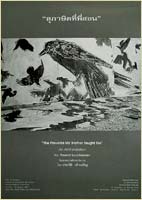 Thai artists living overseas are
generally inspired by their new environments, but home can still
fuel creativity. Thai artists living overseas are
generally inspired by their new environments, but home can still
fuel creativity.Many Thai artists living abroad usually bring their latest art works to be exhibited during a home visit. These works show how the artists' creativity evolves or progresses. Ironically though, many of them have nothing to do with the art sphere of their motherland. Prawat Laucharoen, who settled in the US in 1969, is different. Although his work is based on very abstract and experimental media, such as performance and installation art, this New York-based artist usually comes back with something relating to his motherland. This international artist also explores the theme of Thailand in some of his internationally displayed works. Among them is The Four Elements (1993), listed as a highlight in the First Asian-Pacific Triennial of Contemporary Art in 1993 in Brisbane, an installation questioning the invasion of military dictatorship within major national institutes after the pro-democracy upheaval during 1992. Unfortunately, that acclaimed work has not yet been shown in Thailand. This year, as the country continues to face economic upheaval, Prawat has decided to knock the door of Thailand's art scene again. This is the first solo show by this SoHo based artist in Bangkok since 1987 at the Silpa Bhirasri Institute. His latest exhibition, currently displayed at the Art Centre of Chulalongkorn University, comes under the title The Proverbs My Brother Taught Me. "It is influenced by the way my elder brother used to teach me Thai proverbs when I was a kid," says the Silpakorn University graduate with an MFA degree in painting and printmaking from the Pratt Institute in New York. "As a grown-up, I've pondered those proverbs quite often and how much they have influenced me, and whether they have led me in the right direction of morality. Later, these questions inspired me to create artwork about them. And there is no other country more appropriate than Thailand for exhibiting this work. "Five of the proverbs my brother taught me were chosen as thematic titles for five pieces in this show, in order to provoke local art buffs to think a bit," explained the independent artist, who also teaches at the Horace Mann School in New York. Prawat combines various visual art forms for the presentation of this exhibition: painting, sculpture, mixed media, installation and even architecture. All five pieces are regarded as part of the same narrative set, giving the show a beginning, a middle and an end. |
 |
 |
| Rak Dee Haam Jua Rak Chua Haam Sao |
| Upon entering the Art Centre exhibition
room, the viewer meets the introductory work, the room-within-a-room
piece titled Rak Dee Haam Jua Rak Chua Haam Sao (The good
bear the gable, the bad bear the pillar), with two smaller rooms
inside. The first session is a shadow play on the two gables and the viewers themselves, while the second is decorated with a heavy and bulky pillar. According to this proverb, the gable symbolises light work, while the pillar refers to heavy loads. Its interpretation is that good deeds will result in an easy life. |
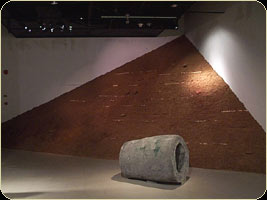 Khen Krok Khuen Khao 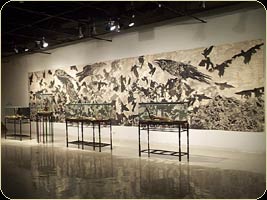 Tee Ngoo Hai Ga Gin 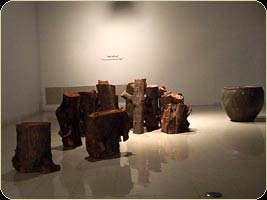 Tak Nam Rod Hua Taw 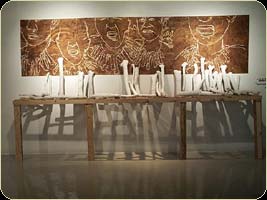 Nua Mai Dai Gin, Nang Mai Dai Rong, Au Kradoog Kwaen Kaw |
Viewers are carried to the next
three pieces which are the exhibition highlights. There is a
huge sculpture called Khen Krok Khuen Khao (Pushing the
mortar up the hill), Tee Ngoo Hai Ga Gin (Beating the
snake to the feed the crow)-a wood-block installation, and Tak
Nam Rod Hua Taw (Watering a stump)-an interactive installation. The first piece is a hill-like wooden structure with a big mortar next to it. The second is a giant wall-sized black-and-white woodblock featuring the image of a murder of crows. In front are four transparent boxes with real snakes inside. The third comprises a pile of wooden stumps in different sizes and heights, with a ceramic jar nearby. The viewers are invited to pour water from the jar over the stumps. Near the exit is the final piece, Nua Mai Dai Gin, Nang Mai Dai Rong, Au Kradoog Kwaen Kaw (No meat to be eaten, no skin to be sat upon, only a bone to be hung around the neck), comprising many hanging bone-like objects, shadows of bones, and a big woodblock in the image of a human skeleton. The meaning of the proverb is that mistaken actions-despite good intentions-can tarnish the doers. Although these five pieces seemingly affirm the typical meaning of the five related proverbs, the artist's notion is to the contrary. Some Thai proverbs, especially those represented by the last four works, aim to teach Thais to refrain from unethical practices, and not to take any unnecessary risks. But today, Thais need to change their mindsets, says the artist. Without taking risks, can the country survive and overcome current problems?On the technical side, all five installation pieces in this show do not follow the typical process of having a clear preconfiguration sketched on paper. Rather, the rough sketches are in his head, and many more elements are later added during the creative process. For the visual art practitioner keen on solving unexpected problems like Prawat, art is a matter of process. The more sophisticated and technically challenging each piece becomes during the creative process, the more he enjoys it. This may be due to his background as a print-maker who is familiar with complex production procedures. Moreover, it also stems from Prawat's nature as a conceptual artist who dares to take risks and to experiment with something really innovative. |